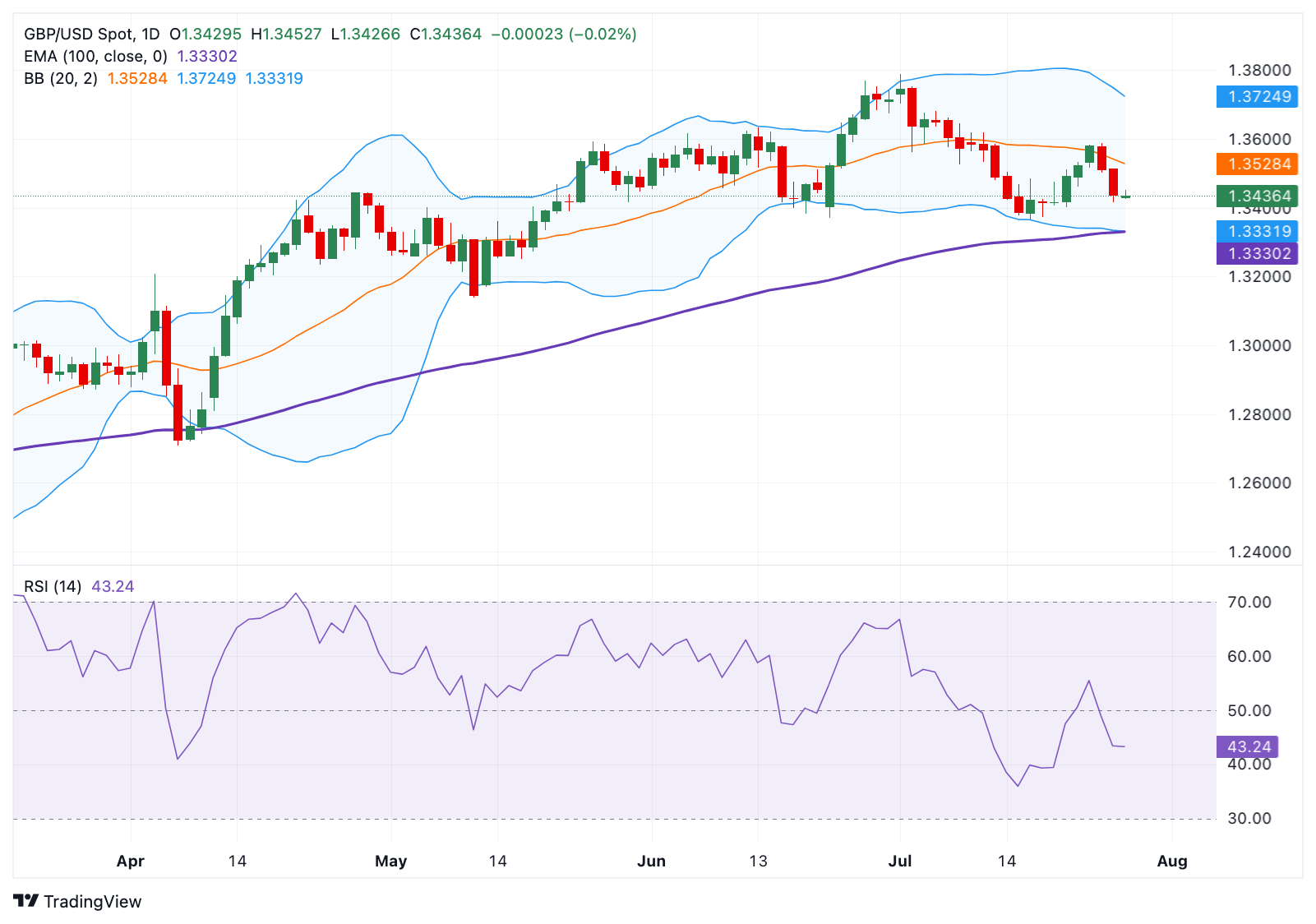GBP/USD Price Forecast: Retains bullish bias above 1.3550 above the 100-day EMA
- GBP/USD trades with mild gains around 1.3440 in Monday’s Asian session.
- The pair keeps the bullish vibe above the 100-day EMA, but consolidation cannot be ruled out in the near term.
- The immediate resistance level is seen at 1.3588; the initial support level is located at 1.3365.
The GBP/USD pair posts modest gains near 1.3440 during the Asian trading hours on Monday. The latest optimism fueled by a trade deal between the United States (US) and the European Union (EU) triggers a fresh wave of the global risk-on sentiment, which boosts the Pound Sterling (GBP). All eyes will be on the US Federal Reserve (Fed) interest rate decision later on Wednesday, with no change in rate expected.
Technically, GBP/USD keeps the bullish vibe on the daily chart, with the price holding above the key 100-day Exponential Moving Average (EMA). However, further consolidation or temporary sell-off cannot be ruled out in the near term as the 14-day Relative Strength Index (RSI) holds below the midline near 43.25.
The first upside target to watch for the major pair is seen at 1.3588, the high of July 24. Extended gains could see a rally to 1.3681, the high of July 4. Further north, the next hurdle is located at 1.3725, the upper boundary of the Bollinger Band.
On the other hand, the initial support level for GBP/USD emerges at 1.3365, the low of July 16. A breach of this level could expose 1.3330, the lower limit of the Bollinger Band. The additional downside filter to watch is 1.3236, the low of May 8.
GBP/USD Daily Chart

Pound Sterling FAQs
The Pound Sterling (GBP) is the oldest currency in the world (886 AD) and the official currency of the United Kingdom. It is the fourth most traded unit for foreign exchange (FX) in the world, accounting for 12% of all transactions, averaging $630 billion a day, according to 2022 data. Its key trading pairs are GBP/USD, also known as ‘Cable’, which accounts for 11% of FX, GBP/JPY, or the ‘Dragon’ as it is known by traders (3%), and EUR/GBP (2%). The Pound Sterling is issued by the Bank of England (BoE).
The single most important factor influencing the value of the Pound Sterling is monetary policy decided by the Bank of England. The BoE bases its decisions on whether it has achieved its primary goal of “price stability” – a steady inflation rate of around 2%. Its primary tool for achieving this is the adjustment of interest rates. When inflation is too high, the BoE will try to rein it in by raising interest rates, making it more expensive for people and businesses to access credit. This is generally positive for GBP, as higher interest rates make the UK a more attractive place for global investors to park their money. When inflation falls too low it is a sign economic growth is slowing. In this scenario, the BoE will consider lowering interest rates to cheapen credit so businesses will borrow more to invest in growth-generating projects.
Data releases gauge the health of the economy and can impact the value of the Pound Sterling. Indicators such as GDP, Manufacturing and Services PMIs, and employment can all influence the direction of the GBP. A strong economy is good for Sterling. Not only does it attract more foreign investment but it may encourage the BoE to put up interest rates, which will directly strengthen GBP. Otherwise, if economic data is weak, the Pound Sterling is likely to fall.
Another significant data release for the Pound Sterling is the Trade Balance. This indicator measures the difference between what a country earns from its exports and what it spends on imports over a given period. If a country produces highly sought-after exports, its currency will benefit purely from the extra demand created from foreign buyers seeking to purchase these goods. Therefore, a positive net Trade Balance strengthens a currency and vice versa for a negative balance.

